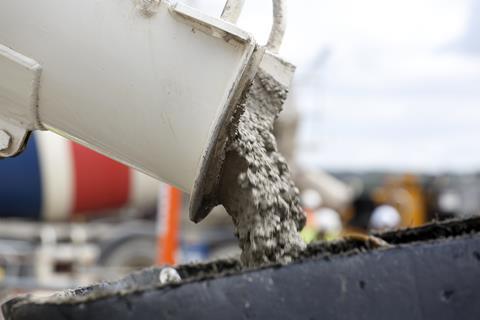Limestone powder can now be added to the material in one of the biggest changes to concrete production “since the 1980s”

Architects will have a new way to decarbonise projects following the British Standards Institution’s (BSI) approval of one of the most significant changes to the traditional recipe for making concrete “since the 1980s”.
Concrete which contains limestone powder has for the first time been added to the BS500 standard for concrete specification under changes published by the BSI.
The national standards body says the new recipe could save one million tonnes of carbon dioxide emissions each year, equivalent to 3,500 transatlantic flights, if the changes are adopted across all UK construction sites.
UK concrete and cement manufacturing currently accounts for 7.7 million tonnes of carbon dioxide emissions, equating to 1.5% of the UK’s total carbon emissions.
The new recipe blends finely ground limestone from UK quarries with other materials such as fly ash, a by-product from coal combustion, and ground granulated blast furnace slag (GGBS), a by-product from the steel industry.
While fly ash and GGBS have been repurposed as ingredients for concrete for many years, they are being produced in smaller amounts due to the transition away from fossil fuel energy generation and carbon intensive steel production.
The BSI said the use of limestone powder is important for helping to provide a sustainable source of materials to continued reduction of emissions from concrete.
The amount of embodied carbon dioxide in concrete can be reduced by 5% for every 5% of limestone powder added to the recipe, according to the Mineral Products Association (MPA) UK Concrete, a group representing the UK concrete industry.
Elaine Toogood, director, architecture and sustainable design at the Concrete Centre, said the new approved standard would help architects and engineers significantly lower embodied manufacturing emissions while delivering structural strength in buildings and infrastructure.
“Providing a new generation of concretes are an important part of the UK concrete and cement industry’s roadmap to net zero alongside other technologies including the use of decarbonised transport, fuel switching and carbon capture, usage or storage technology,” she said.
The new specification changes are part of a rigorous research and testing process over two years with the results then independently assessed for inclusion into the standard by the BSI technical committee for concrete.
Absolute carbon emissions from concrete have already been reduced by 53% since 1990 and the material is decarbonising, as a whole, faster than the UK economy.
















2 Readers' comments